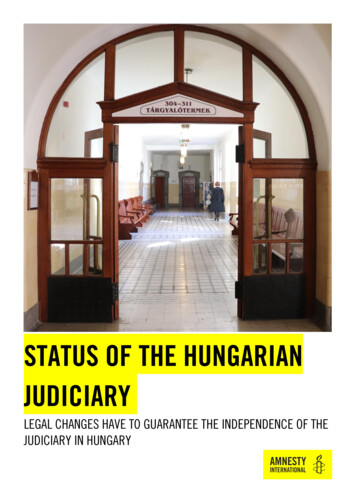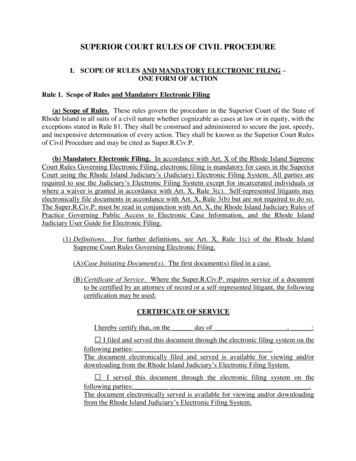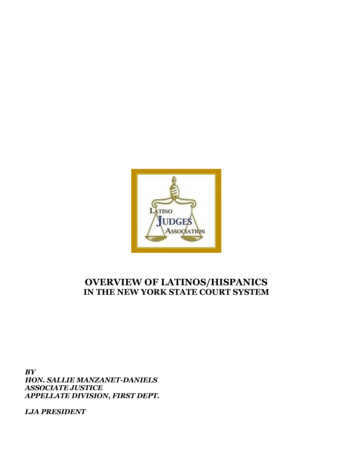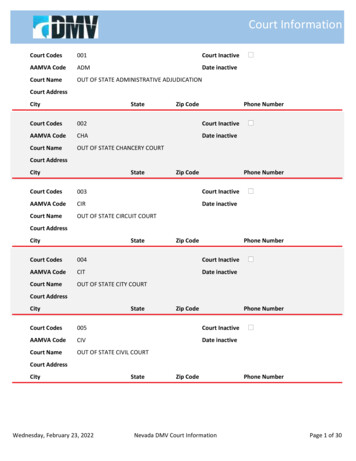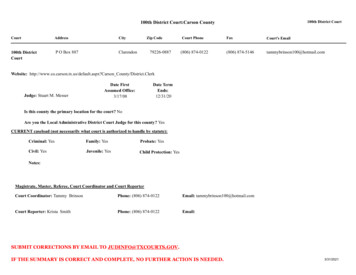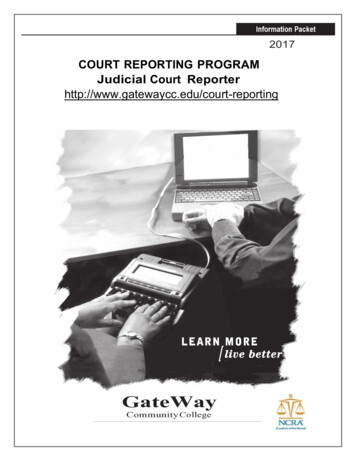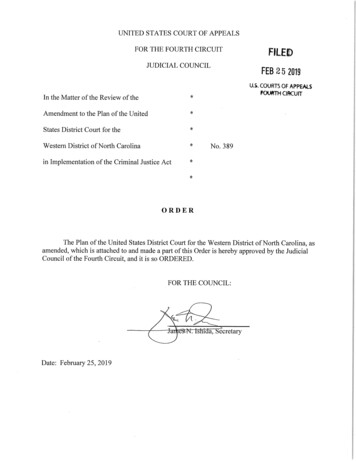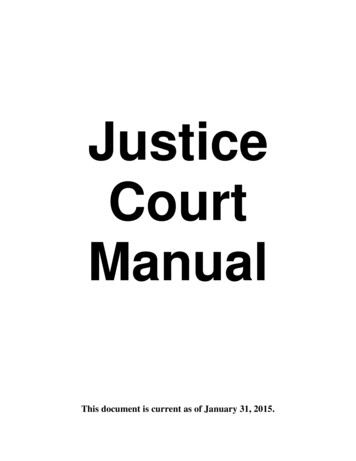
Transcription
JusticeCourtManualThis document is current as of January 31, 2015.
Town and Village Justice CourtsTable of ContentsPREFACE . 5I.OVERVIEW: HOW TO USE THIS MANUAL. 6II.OVERVIEW OF THE JUSTICE COURT SYSTEM . 7A.New York State’s Town and Village Courts . 7B.What are the Functions of the Town and Village Courts? . 81.Civil Actions and Proceedings . 82.Criminal Actions and Proceedings . 93.Traffic and Parking Violations . .9i. Adjudicating "Traffic Infractions" . .9ii. Traffic Violations Bureau . . 104.State Laws Granting Justice Court Jurisdiction . 115.Provisional Remedies, Process, and Search Warrants . 116.Contempt of Court . 127.Marriages and Oaths . 128.Special Considerations for Justice Courts within the District of a District Court . 12C.General Oversight by the State . 13D.Other Justice Court Stakeholders . 131.Police Agencies: Transporting Defendants from County Correctional Facilities .142.District Attorneys .143.Indigent Criminal Defenders 144.Civil Legal Service Providers . .14III.JUSTICE COURT ADMINISTRATION . 16A.Introduction . 16B.Separation of Powers: Local Discretion and Judicial Independence . 16C.Supervision of Court Personnel, Establishment of Court Personnel Salaries, and Court Personnel Policies . 191.Creation and Abolition of Offices . 19i.Justices . .19ii.Non-Judicial Personnel .21iii. Enforcement Officers .22iv.Full-Time versus Part-Time Positions . .22v.Appointment and Termination, and Training .22vi. Civil Service Rules . 23vii. Oaths of Office and Undertakings . .23viii. Fingerprinting Requirements for Justices and Judicial Staff . 242.Non-Judicial Personnel: Supervision and Employment Policies . 253.Compensation: Salaries and Benefits . .26i.Non-Judicial Personnel Compensation . 26ii.Working Within Staff Appropriations . 26iii.Judicial Compensation . 27D.Vacancies in Judicial Office . 281.Creation of Vacancies . 282.Resignations . 283.Filling Vacancies . 29i.Vacancies in the Office of Town Justice . . .29ii.Vacancies in the Office of Village Justice and Acting Village Justice. 29iii.Temporary Assignment of Justices . .302
[Type text]E.F.G.4. Vacancies in Non-Judicial Office . 30Criminal Proceedings in the Justice Courts . 301.Protecting Criminal Defendants’ Right to Counsel . 302.Defendant’s Right to Counsel at Arraignment . 323.Determining Defendant's Eligibility for Assigned Counsel. . 334.Criminal History Reports of Defendants (RAP Sheets) .345.Recording Criminal Proceedings . 356.Criminal Trials and Juries . 357.Appeals . 35Justice Court Operations . 361.Court Facilities . 362.Court Security .36i.Dedicate Space Exclusively for Justice Court Use. . .37ii.Eliminate Potential Courtroom Weapons. . . . .37iii. Create Strategic Barriers. . . 37iv. Eliminate Strategic Lines of Sight. . . 38v.Secure Courtroom Furniture. . 38vi. Provide Uniformed and Armed Security Presence. . 38vii. Provide Ingress Screening. . . .39viii. Secure and Illuminate Parking . . .39ix.Arrange Armed Escort for Bank Deposits . .39x.Secure Storage of Cash and Negotiable Instruments . . 39xi.Provide Duress Alarms in Strategic Places . . 403.Setting Court Hours . 404.Setting Office Hours . 405.Access to Justice Court Records . 40i.Custody of Records . .41ii.Records Management Responsibilities. . . .42iii. Records of Dissolved Justice Courts. 436.Judicial Ethics . .437.Judicial Campaign Ethics . 44Justice Court Fiscal Administration . 441.Establishing Justice Court Budgets . 442.Reporting Monthly to the State Comptroller. 453. Annual Audit Requirements . 45i.Justice Court Recordkeeping Requirements . . .464. Distribution of Fines Collected by the Justice Court . 585. Fees under General Municipal Law § 99-l . 606. Handling Justice Court Funds . 61i.Internal Controls: Accounting Process and Records. . . . .62ii. Receipts. . 62iii. Disbursements. . . 63iv. Reconciling Cash Book Balances with Adjusted Bank Balances. . .64v.Bank Reconciliations. .65vi. OCA Credit Card Machine Program. . . .66vii. New Credit Card Machine Payment Program 66viii. Credit Card Controls . . .677. Insuring a Justice Court .698. Protecting Justice Court Data Security . .69i.Periodic Backups and Secure Duplication of Electronic Data .70ii. Protections Against Unauthorized Use .70iii. Protections Against Alteration .709.Internal Control Responsibilities of Governing Boards .713
[Type text]H.IV.Funding Sources for Routine Justice Court Administration . 711.Justice Court Assistance Program . 712.Records Management Grants . 723.Justice Court Audits . 72INTER-MUNICIPAL COOPERATION 74A. Inter-Municipal Cooperation Pursuant to General Municipal Law Article 5-G .75B.C.D.E.1. Getting Started . .752. The Form of the Inter-Municipal Agreement (IMA) 753. Approval of the Agreement .76Factors to Consider when Reviewing Whether and How Much to Engage in Inter-Municipal Cooperation .77Justice Courts and Tax Cap “Transfers of Function” . 78Prohibition Against Binding Future/Successor Boards .79Potential Options 801.Share Court Facilities (UJCA § 106 / GML Art 5-G) . 802.Elect a Single Judge for Multiple Justice Courts (UJCA § 106-b). 823.Share Facilities and a Single Justice for Multiple Justice Courts .834.Merge Courts and Select Justices From Each Town (UJCA § 106-a) . 835.Create a Village Justice Court (Village Law § 3-301 (2)(a)) .856.Adding an Additional Village Justice (Village Law § 3-302 (3)) .857.Abolish the Village Justice Court (Village Law § 3-301 (2)(a)) . 858.Handling of Records of a Dissolved Village Justice Court .869.Propose an Alternative Approach . 8710. Best Practices for Exploring Inter-Municipal Cooperation . 8711. Identify Opportunities . 8812.Conduct a Feasibility Analysis. 8813.Negotiate the Agreement: Important Questions to Answer . 8914. Build and Maintain Support . 9015. Anticipate and Plan for Potential “Roadblocks” . 90APPENDIX A .98APPENDIX B .100APPENDIX C .101APPENDIX D .1034
Town and Village Justice CourtsPrefaceIt is with great pleasure that I introduce the New York State Justice Court Manual. This Manual, aproduct of the Justice Court Task Force, is New York’s first one-stop-shopping handbook of best practices toefficiently operate a Justice Court consistent with both local needs and the interests of the administration ofjustice. This Manual also offers town and village governments invaluable advice about combining, sharing, andotherwise adapting their Justice Courts to fiscal, operational, and other local needs.The Justice Court Task Force, and this Manual, appear in a time of fiscal constraint and close focus onlocal governance. Like all public instrumentalities in New York State, wise stewardship of Justice Courts isimportant to keep the public trust vested in them and make efficient use of limited taxpayer funds. Ensuringthat Justice Courts reflect these realities is both important and fraught with complexity due to the many fiscal,operational, constitutional, and statutory issues that shape Justice Courts. The Task Force's work of identifyingneeds and concerns, researching best practices and governing laws, sifting through and synthesizing all of theinformation, coming to consensus, and developing this Manual, was no small mandate.In this mandate, the Task Force’s mission – and one of this Manual’s guiding values – is to recognizeand empower a town and village discretion to the maximum extent practicable. Under State law, each JusticeCourt represents collaboration between its sponsoring locality, the State, and the justice stakeholders appearingin or affected by the courts operations. I hope this Manual promotes the wise collaboration that is key tohealthy Justice Courts and their effective administration of justice.In their discretion, localities sponsoring Justice Courts are asking questions about potentiallyreconfiguring their local courts. This Manual offers objective advice about options to share facilities, mergecourts, restructure judgeships, and undertake other reforms to improve the local administration of justice.Although this Manual is an impressive document in its thoroughness and completeness, perhaps what ismost impressive is that it represents the collective voice of so many groups and agencies that have somethingimportant to say about Justice Courts and their optimal functioning. You will see these groups listed in theappendix of this Manual. This Task Force was able to take their many legitimate points of views and stillachieve this goal. Because the Justice Court environment constantly changes, this Manual is intended to be aliving document and will be updated periodically as the need arises.I would like to thank the co-chairs and members of the Task Force for their hard work and contributionsto developing this Manual. I know that it will educate and inform local governments in making the bestdecisions about Justice Courts for their communities.Honorable Michael V. CoccomaDeputy Chief Administrative JudgeUnified Court System5
Town and Village Justice CourtsI.Overview: How to Use This ManualTown and Village Justice Courts are part of New York State’s complicated web of judicial institutions and playvital roles in both criminal and civil actions. The purpose of this Manual is to provide an overview of theJustice Courts, including the types of cases they handle, how they operate, how a village may establish orabolish a Justice Court, and how towns and villages can collaborate to provide better administration of justiceand operate more efficiently.This Manual is intended to support justices, town and village governing boards, Justice Court clerks and othernon-judicial staff of the Justice Courts, municipal chief financial officers, and other municipal officials who areinvolved or interact with Justice Court operations. Its contents reflect best practices recommended by theOffice of the State Comptroller, Office of Court Administration, New York State Association of Towns, NewYork State Conference of Mayors, New York State Magistrates’ Association, and other key stakeholders in theJustice Court system. These stakeholders comprise the Justice Court Task Force, which is responsible fordeveloping this Manual. A list of the Justice Court Task Force’s participants is included in the appendix of thisManual.While this Manual aspires to be comprehensive, it is not designed to provide legal or operational advice withregard to particular issues that may arise in a specific Justice Court at a particular time. Justice Courts and theirsponsoring municipalities always are encouraged to seek appropriate advice concerning these issues as theyarise.If questions arise about Justice Court operations, Town and Village Justices should contact the Office of JusticeCourt Support or their Supervising Judge. Town and village officials should contact their municipal attorney,the Association of Towns or the Conference of Mayors.6
Town and Village Justice CourtsII.Overview of the Justice Court SystemA. New York State’s Town and Village CourtsWithin New York’s complex judicial system are nearly 1,300 Town and Village Justice Courts.1 Justice Courtsare governed by the Uniform Justice Court Act (“UJCA”), first enacted in 1967, as well as a host of otherstatutes, executive-branch regulations, and rules enacted by the State Judiciary.Most of New York’s town and villages operate a Justice Court. Together New York’s nearly 2,200 Town andVillage Justices handle almost two million cases per year. Justice Courts vary in their number of justices,volume and types of cases, hours and frequency of scheduled court dates, number of non-judicial employees,and costs of operation. Many factors shape these aspects of Justice Court operations, some of which are mattersof local discretion.In general, Justice Courts are empowered to hear both civil and criminal cases, but are courts of limitedjurisdiction in that they adjudicate only certain types of civil and criminal cases. On the civil side, JusticeCourts hear money actions that do not exceed 3,000, with very narrow exceptions. 2 On the criminal side,Justice Courts are local criminal courts with the same jurisdiction as the New York City Criminal Courts,District Courts and City Courts outside New York City, with the power to adjudicate misdemeanor and pettyoffenses, and arraign defendants in felony cases before they are transferred to a superior court (usually theCounty Court).3While Justice Courts have limited jurisdiction, they are integral parts of New York’s Unified Court Systemcomprising the Judicial Branch of New York State government. 4 As such, each Justice Court is responsible foradministering justice consistent with the Constitution and its separation of powers, as well as applicable statutesand court rules, and subject to the general oversight of the Chief Judge and Chief Administrative Judge. EveryTown and Village Justice, and every municipal official interacting with the local Justice Court, sharesresponsibility for ensuring the effectiveness of the Justice Court under our Constitution, the UJCA, and otherstatutes that govern aspects of Justice Court operations – including the Judiciary Law, Civil Practice Law &Rules (“CPLR”), Criminal Procedure Law (“CPL”), Real Property Actions and Proceedings Law (“RPAPL”),Vehicle and Traffic Law (“VTL”), General Municipal Law (“GML”), Town Law, and Village Law.1There is frequent confusion regarding the term “court of record.” While technically Justice Courts are notcurrently courts of record, see N.Y. Const., art. VI, § 1(b); Judiciary Law § 2, all Justice Court proceedingsare subject to electronic recording and the Criminal Procedure Law applies in all criminal courts whether ornot the court is of record. See CPL 10.10.2See generally UJCA § 202.3See generally UJCA § 2001; CPL 10.30.4See NY Const, art VI, § 1(a); Judiciary Law § 1; UJCA § 102.7
Town and Village Justice CourtsB. What are the Functions of the Town and Village Courts?Town and Village Courts play vital roles in the New York State Unified Court System. These courts havejurisdiction and hear both civil and criminal matters.A court’s powers are limited by its subject matter jurisdiction. Jurisdiction is the legal term that describes theauthority of a court to hear and determine certain types of cases and its power over individuals, legal entities,and property that are the subject of actions before it. Justice Courts derive most of their basic civil and criminalsubject matter jurisdiction from UJCA §§ 201-203, 2001, and CPL 10.30.1. Civil Actions and ProceedingsThe civil jurisdiction of Town and Village Courts includes the power to hear actions seeking monetary awardsup to 3,000, and small claims proceedings for awards up to 3,000. Town and Village Courts are perhaps bestknown for their small claims parts. Small claims proceedings are intended to provide a low-cost, simplified, andinformal procedures for individuals to resolve disputes involving limited monetary claims. Often litigantschoose not to be represented by attorneys in small claims matters. Upon the commencement of a small claimsaction, the court is required to furnish every claimant with "A Guide to Small Claims in the NYS City, Townand Village Courts."5 Copies of this booklet may be obtained by contacting the Office of Justice Court Supportor online at Handbook.pdfJustice Courts’ civil jurisdiction also extends to actions and proceedings to recover money or chattel6 where theamount of the money at stake or the value of the property to be recovered does not exceed 3,000, exclusive ofcosts and interest.7 Justice Courts also have jurisdiction over summary proceedings to: Recover possession of real property located in whole or in part within the town or village for whichthe Justice Court presides; Remove tenants from such real property; and Render judgment for rent due without regard to the amount in controversy.8Violations of town or village local laws or resolutions, which are subject to civil penalties not exceeding 3,000per event, also can be heard in the local Justice Court. Justice Courts, however, do not have the power to grantprovisional remedies, such as injunctive powers, relative to town and village ordinances.5See UJCA § 1803 (b).6Chattel is personal property as distinguished from real property.7See UJCA § 202.8See UJCA § 204; RPAPL § 701.8
Town and Village Justice Courts2. Criminal Actions and ProceedingsIn addition to their civil jurisdiction, Justice Courts are authorized to handle criminal cases involving theprosecution of misdemeanors, violations and traffic infractions allegedly committed within the geographicboundaries of the town or village for which the Justice Court presides.9 Justice Courts have exclusive trialjurisdiction over petty offenses, which consist of violations and traffic infractions, but superior courts havejurisdiction over petty offenses when charged in an indictment that also charges a crime. 10 Justice Courts sharetheir trial jurisdiction over misdemeanors with superior criminal courts (i.e. County Court or Supreme Court),which can divest (i.e. take control of) cases from Justice Courts under certain circumstances.11 Justice Courtprocedure in criminal actions and proceedings is subject to the Criminal Procedure Law.12Town and Village Justices comprise the largest corps of New York judicial officials who are potentially on-call24 hours a day to arraign criminal charges and issue orders of protection or enter certain emergency orderswhen Family Court is not in session. In cases involving domestic violence, Town and Village Justices havejurisdiction to issue temporary orders of protection during off-hours.3. Traffic and Parking Violationsi. Adjudicating “Traffic Infractions”13While traffic infractions are not crimes and their penalties are not criminal in nature, 14 the Criminal ProcedureLaw classifies traffic infractions as “petty offenses.”15 Therefore, traffic infractions must be heard before a9See UJCA § 2001; CPL 10.30.10See CPL 10.20(c). Petty offenses are not crimes.11See CPL 10.30.12See People v Hickey, 40 NY2d 761 (1976) (Justice Courts are local criminal courts and, as such, possesstrial jurisdiction of all offenses other than felonies and preliminary jurisdiction over all offenses, subject todivestiture by a superior court); People v Lindsly, 99 AD2d 99 (2d Dept. 1984), appeal withdrawn 62 NY2d987 (any conflict between CPL and UJCA in connection with Justice Court criminal jurisdiction is resolvedin favor of the latter). In general, the jurisdiction of Justice Courts and the disposition of fines and penaltiesfor violations of rules and regulations of State agencies contained in the NYCRR is the same as forviolations of the pertinent statutes themselves. See Ops St Comp No. 80-10.13When dealing with parking and traffic tickets, terminology can be confusing. A violation of any provisionof the Vehicle and Traffic Law or any local law, ordinance, order, rule, or regulation adopted pursuant to theVehicle and Traffic Law is a “traffic infraction.” See VTL § 1800. State law may declare that the violationis a misdemeanor or felony. “Traffic infractions” include “traffic violations” and “parking violations.”“Parking violations” are violations of parking, stopping, or standing restrictions. VTL § 155. “Trafficviolations” constitute all other “traffic infractions.”14See VTL § 155.15See CPL 1.20 (39).9
Town and Village Justice Courtscourt with jurisdiction for the location in which the case arises. 16 Municipal clerks do not have authority orjurisdiction to accept pleas or assess fines on traffic tickets or parking tickets in lieu of a judge. Traffic andparking tickets issued in a town or village must be made returnable before the local Justice Court havingjurisdiction in the location where the alleged infraction occurred.ii. Traffic Violations BureauA town or village may, by local law or ordinance, authorize the Justice Court having jurisdiction over trafficcases arising in the town or village to establish a traffic violations bureau to assist in disposing traffic andparking infractions.17 A traffic violations bureau may be authorized to accept guilty pleas to violations of trafficand parking laws, ordinances, rules, and regulations. A traffic violations bureau cannot accept guilty pleas tospeeding offenses, misdemeanors, or felonies;18 these matters must come before the court itself. P
Town and Village Justice Courts 7 II. Overview of the Justice Court System A. New York State's Town and Village Courts Within New York's complex judicial system are nearly 1,300 Town and Village Justice Courts.1 Justice Courts are governed by the Uniform Justice Court Act ("UJCA"), first enacted in 1967, as well as a host of other
